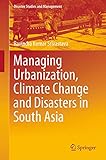Managing urbanization, climate change and disasters in South Asia [electronic resource] / Ravindra Kumar Srivastava.
Material type: TextSeries: Disaster Studies and ManagementPublication details: Singapore : Springer, 2020.Description: 1 online resource (501 p.)ISBN:
TextSeries: Disaster Studies and ManagementPublication details: Singapore : Springer, 2020.Description: 1 online resource (501 p.)ISBN: - 9789811524103
- 9811524106
- Urbanization -- South Asia
- Climatic changes -- South Asia
- Natural disasters -- South Asia
- Environmental policy & protocols
- Sustainability
- Sociology
- Development economics & emerging economies
- Urban economics
- Science -- Global Warming & Climate Change
- Business & Economics -- Development -- Sustainable Development
- Social Science -- Sociology -- Urban
- Business & Economics -- Development -- General
- Business & Economics -- Urban & Regional
- Climatic changes
- Natural disasters
- Urbanization
- South Asia
- 307.760954 23
- HT147.S64
| Item type | Current library | Shelving location | Call number | Status | Date due | Barcode | Item holds | |
|---|---|---|---|---|---|---|---|---|
 Electronic Book
Electronic Book
|
Kuakarun Nursing Library | Processing unit | Online Access | eb36047 |
Description based upon print version of record.
3.6 Disaster Trends: Global, Regional, National and Local
Includes bibliographical references.
Intro -- Preface -- Acknowledgements -- Contents -- About the Author -- List of Figures -- List of Tables -- 1 Risk Profiles of South Asia-Urbanization Context -- 1.1 Overview of Hazard, Risk and Vulnerability (HRV) of Contextual Region -- 1.1.1 Context of Geophysical Features -- 1.1.2 Context of Climate Change -- 1.1.3 Context of Urbanization -- 1.2 Socio-economic Developments: New Challenges -- 1.2.1 Challenges of Sustainable Development -- 1.2.2 Climate Change and Urbanization in SAR -- 1.2.3 Effects of Climate Change on Urbanization
1.2.4 Increased Use of Energy in Urban Areas: One of the Causes for Climate Change -- 1.3 Challenges in Building Urban Risk Resilience (URR) -- 1.3.1 Urbanization Led Non-linear Causes of GHG Emission: An Analysis -- 1.3.2 Recognizing and Mapping Risk and Hazard Sources -- 1.3.3 Inconsistent and Incoherent Steps Towards Preventive Measures -- 1.3.4 Action Space in Adaptation -- 1.3.5 City Climate: Adaptation Plan -- 1.3.6 Lack of Multi-level Institutional Coordination -- 1.3.7 Urban Settlement Incongruent with Different National Missions on Sustainable Settlement Plans
1.3.8 Inadequacies in Decentralization and Service Delivery Mechanism -- 1.4 Analyzing Gap in Extant Management of DRR, CCA and Urban Governance -- 1.4.1 Lack of R&D on Mainstreaming CCA and DRR in Development Planning -- 1.4.2 Institutional Structures Governing DRR, CCA and Urbanization-Harmonizing Synergies -- 1.4.3 Empowering Financial Strengths and Legal Safeguards of Urban Governing Structures: A New Resolve -- 1.5 SAR to Re-calibrate Its Urbanization Agenda -- References -- 2 South Asia Region and Its Urban Agglomerates: The Risk Characterization -- 2.1 General
2.2 Demographic, Social and Economic Variation -- 2.3 Disaster and MDGs -- 2.4 Geophysical Features and Associated Risks -- 2.4.1 Mountain Ranges in SAR -- 2.4.2 Rivers -- 2.4.3 Coastal Area -- 2.4.4 Forests -- 2.5 Urbanization-A New Mainstay of Changing Landscape -- 2.5.1 Global Trend -- 2.5.2 Trends of Urbanization in SAR -- 2.5.3 Demographic Pattern in South Asian Mega Cities -- 2.6 Urbanization Trend in South Asia -- 2.6.1 Afghanistan -- 2.6.2 Bangladesh -- 2.6.3 Bhutan -- 2.6.4 India -- 2.6.5 Maldives -- 2.6.6 Nepal -- 2.6.7 Pakistan -- 2.6.8 Sri Lanka
2.7 Impacts of Geophysical Features and Climate Change on Urbanization -- References -- 3 Managing Disaster in South Asia -- 3.1 General -- 3.2 Disaster Management: Terminology, Concepts and Practices -- 3.3 Key Terms of DRR -- 3.3.1 Disaster -- 3.3.2 Hazard -- 3.3.3 Vulnerability -- 3.3.4 Capacity -- 3.3.5 Disaster Risk -- 3.3.6 Disaster Management -- 3.3.7 Risk Management -- 3.3.8 DRR -- 3.4 Concept of Disaster Resilience -- 3.4.1 Resilience: A Prerequisite to DRR -- 3.4.2 Initiative for Minimizing Disaster Risk and Enhancing Community Resilience -- 3.5 Disaster Management: Key Stages
This book offers essential insights into potential catastrophic events that might befall upon the emerging urban landscape in South Asia, and which are due to hazards, risks and vulnerabilities inherent in the regions geophysical location, as well as due to climate change and unplanned urbanization. It highlights major physio-graphic, demographic, geological and geophysical indicators that are responsible for changing the pattern and trend of urbanization in South Asia - a crucial issue in view of emerging threats of climate change, and changes in the demographic profile. The book addresses the disaster management scenario in South Asia, manifestations of climate change in the region and various urban setups under climate-change-induced risks. Further, it elaborates on the challenges of urbanization-based neo-risks and vulnerabilities, which manifest in the form of slum area growth, piling and littering of waste and filth, new health risks, groundwater contamination, air pollution, highly energy-dependent lifestyles, poverty, socio-economic tensions, etc. It also critically examines the institutional mechanisms for disaster risk reduction (DRR), climate change adaptation (CCA) and urban governance, and suggests appropriate changes in the governing structure to mitigate these risks. The book draws the attention of urban planners and policymakers to current shortcomings in the administrative and financial structures of local urban bodies. While outlining climate-associated risks and adaptation strategies in South Asia, it also suggests measures for integrating climate change and urban adaption with state's planning processes, and puts forward a risk alleviation platform to bring the risk managers working in different fields together, so that they make concerted efforts to achieve sustainable development. It offers valuable takeaways for researchers, urban planners, those working in industry, consultants, and policymakers.
Added to collection customer.56279.3
There are no comments on this title.

